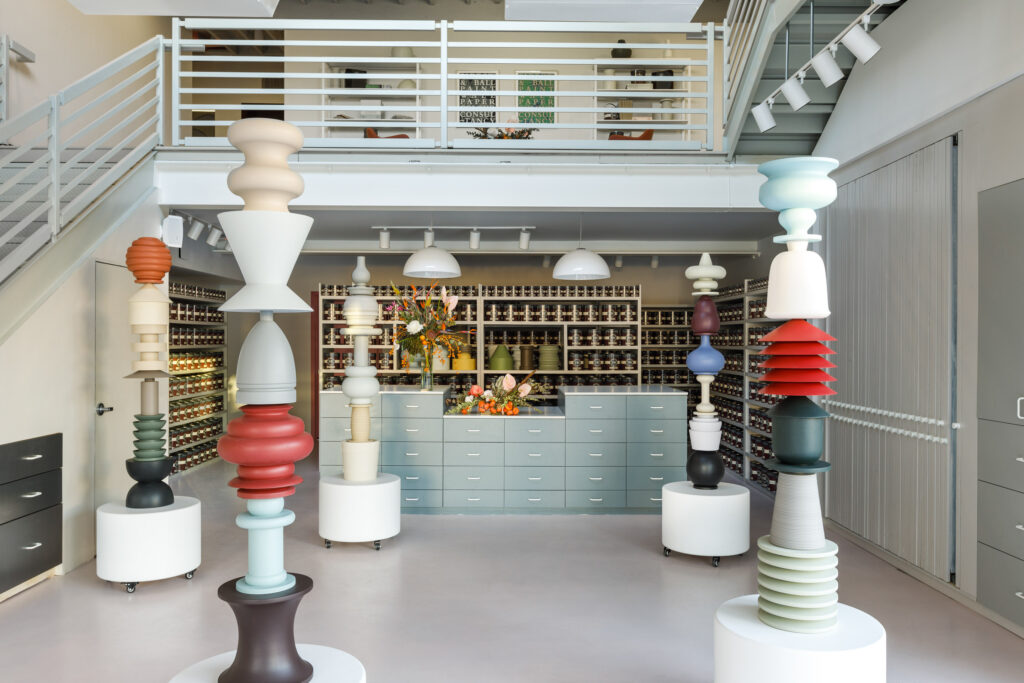The history of Farrow & Ball is as colorful as its vibrant palette of paints—and storefront on La Cienega. John Farrow was a trained chemist who spent the Second World War working for Agnew Paints in Ireland; Richard Ball, an engineer captured in France and held as a prisoner of war. At the end of the conflict, each man returned to Dorset, and met, without ceremony, at a local clay pit.
Discovering a shared passion for quality ingredients and traditional methods, the men founded Farrow & Ball in 1946—a passion “we still uphold today” and “ in the very same place where the Farrow & Ball story started,” explains Charlotte Cosby, the company’s head of creative.
The austerity that impacted Britain in the years following the war also impacted Farrow & Ball, but by the early 1950s, the company was supplying paint to the Admiralty, Raleigh bikes, and the motor industry. Years passed largely without incident, until a fire destroyed the company’s original Verwood factory in the 1960s, prompting the operation to move to a site in Wimborne, where its paints and wallpaper are still produced.
Midway through the 20th century, Farrow & Ball’s intrepid stewards retired from the company they forged by stepping away from cheaper acrylic paints with high levels of plastic to stick with original formulations and natural ingredients for their efficacy. “This is something we’ve stuck to for over 70 years,” says Cosby. “Even in the 1970s and 1980s, when many brands were creating acrylic paints with added plastics and fewer pigments,” Farrow & Ball was doing it their way, switching to its eco-friendly water base in 2010, but not before a raft of changes in the 1990s—its first independent stockist, a flagship in Chelsea, and the company’s acquisition by Tom Helme, an advisor on historic interiors, and Martin Ephson, a corporate financier.
Under their leadership, the company focused on restoring heritage properties with colors that were sympathetic to their era and manufactured its first rolls of wallpaper. That was in 1995. Now this fantastically popular part of the Farrow & Ball range will embrace the first line of 25 metallic wallpapers—100-percent recyclable and made with responsibly-sourced paper and eco-friendly water-based paint—this spring.
For all its advancements, the Farrow & Ball of today is a lot like the Farrow & Ball of yesterday—same quality, same ingredients—but the luxury brand that admirably keeps in lockstep with its cornerstones has not forsaken the needs of the modern consumer, developing its technology, and collaborations with kindred businesses like The Rug Company, which teamed with Farrow & Ball in 2017 to launch the latter’s first collection of beautiful, high-quality, responsibly-made rugs in colors that complemented the company’s richly pigmented palette.
For Los Angeles consumers, Farrow & Ball—in addition to finding it in international cultural institutions including the Museum of Modern Art and Musée Rodin—has its West Hollywood showroom, quite a colorful store where so much is neutral territory.
But Farrow & Ball’s School House White No. 291, Shadow White, Shaded White and Drop Cloth, each created to look like white when used in deep shade, fits the local aesthetic. The brand’s neutrals have remained enduringly popular through the years, says Cosby. But, as people move away from grays “in favor of something bolder and more dramatic,” she recommends the brand’s darker blues.
Regardless of the tone of the moment, Farrow & Ball is here, doing what it’s done for 70 years, painting—and papering—the town, from Dorset to Los Angeles. farrow-ball.com
PHOTOGRAPHS: COURTESY OF FARROW & BALL; LA STOREFRONT IMAGES BY LAURE JOLIET








